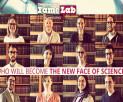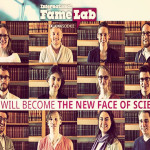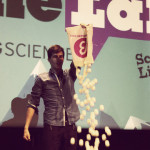Tough competition in Famelab finale
It has been two months since PhD student Ludo Cornelissen and master’s student Timothy Sondej blew the judges away during the Famelab qualifying round in Groningen. Cornelissen explained his physics research by almost dancing across the stage, and neuroscientist Sondej got us all thinking about free will. On Friday, they had to prove themselves to the judges whilst going up against ten other finalists for a place in the international final round.
Another Groninger
The guys boarded the train with yet another finalist from Groningen that afternoon. Bachelor’s student Nicole Mascarenhas, who competed in the qualifying round in Wageningen, turns out to be studying at the RUG as well. ‘I missed the deadline for signing up for the qualifying round in Groningen’, says Mascarenhas. ‘So I competed in Wageningen instead.’ In Wageningen, she won the jury over with her story about the ‘bystander effect’, so the RUG is well represented in the national finale.
‘Is the tumor responsible for the murders or the person himself?’
The candidates have had to adjust their stories. One of the rules of the Famelab is that you cannot reuse the story you used in the qualifying round. But just how different the story has to be is not exactly clear. For this reason, the majority of the candidates stay close to their original pitch. ‘It is actually quite strange that you have to change your pitch’, says Cornelissen. ‘After all, isn’t that what you won the qualifying round with?’ Luckily, all of the candidates from Groningen are confident that their new stories will be good enough.
Last in line
As the finalists disembark from the train in Utrecht, the tension rises. In the Academy building, the other candidates and a small buffet await them, but truly relaxing over a meal is not in the cards. ‘It’s cosy, but you’re just really nervous’, says Cornelissen. After eating, they spread out across the building. Sondej practices his pitch again a few times in a quiet corner, while Mascarenhas gets a few tips from a friend. Cornelissen does not practice again: he knows his story by now.
Friends, family and interested parties pour in until the auditorium is more than half full. The Groningers are the last ones to pitch, so they have to keep their nerves in check for a little while. Sondej finds the wait tedious on the one hand, but also feels that it could be an advantage: ‘The last competitor might linger the most in the judge’s minds.’
The first candidates do not waste any time. Visual comparisons and props such as balloons, molecular structures and even a quantum dot costume are used. After nine pitches, it is Sondej’s turn to take the stage with his story about a murderer who turned out to have a brain tumor: ‘Is the tumor responsible for the murders or the person himself?’ It is a clear and intriguing story. Next, Cornelissen makes good use of his body again – in by far the most enthusiastic pitch of the evening – to explain the concept of spin valves. Mascarenhas talks about how we could all become heroes, but occasionally her story falters. ‘I improvised the whole piece’, she admits after leaving the stage. ‘I forgot my whole story.’
Public prize
While the judges deliberate, the audience can vote for the winner of the public prize. The standard is high and many do not know exactly which pitch they liked the best. It takes a while before the judges reach a decision. In the end, first place goes to Bert Vercnocke from the University of Amsterdam, with his inspiring story about string theory and a parallel universe. It is a shame, feels Cornelissen: ‘I gave myself a good chance, as I got good responses from those in the room. But it was all very close, and most of all, I am happy that I got the chance to present my research.’
Videos of all participants in Famelab 2016 can be found at the Kennis van Nu YouTube channel, including this one by the public prize winner Timothy Sondej.
There is, however, a small victory for the Groningers, as Sondej wins the public prize. ‘I asked lots of friends to vote’, he laughs. ‘And I also mentioned it when I was teaching. That probably helped.’ The win entitles Sondej to an internship at the NTR (the independent Dutch public service broadcaster), but he does not know just yet what he is going to do there. ‘I would possibly like to do a report on Cheltenham festival, where the international finale will be held; or maybe something completely different, as long as it creates more scientific communication!’
Famelab
This year, Famelab was organised for the third time in the Netherlands by The British Council in collaboration with various universities. The best two competitors from each of the six qualifying rounds earned a spot in the national finale in the Academy building in Utrecht. Leading up to the finale, they received a two-day masterclass in scientific communication, organised by the science organisation KNAW. The winner of the national competition will represent the Netherlands during the international finale in England and compete against entrants from around 30 different countries. There is also a public prize: an internship at the NTR.






